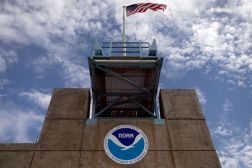From checking the weather app on your smartphone to looking online for the water levels in a nearby stream, civil Earth observations — data pulled from Earth-observing systems — have become an integral part of how one interacts with the data of daily life. And in its National Plan for Civil Earth Observations, the White House Office of Science and Technology Policy looks to set the course for the role the federal government will continue to play in these observations.
The plan, announced by Timothy Stryker, the director of the OSTP’s U.S. Group on Earth Observations program, in a blog post on the OSTP website, attempts to maximize the value of observations collected by federal agencies and advance observation systems.
“Americans and people around the world benefit from Earth-observations data every day,” Stryker said. “Have you ever used your smartphone to get a weather forecast? Turned on the TV to check beach conditions? Read a newspaper or magazine article describing the relationship of extreme weather events to climate change? These services are driven by Earth-observations collected by the federal government, which are made routinely available to app-developers, news and weather organizations, mapping services, the scientific community and the general public.”
Improved coordination of these Earth observations will ensure the data derived from them can be used more widely and efficiently across the federal government, in addition to using the data to serve citizens, according to the report.
But efficiency is not the only possible benefit of improving the way Earth observations are handled at the federal level; the plan said there could be a possible economic benefit as well.
“The U.S. government is the largest provider of environmental and Earth system data in the world,” the plan states. “Conservative estimates indicate that federal Earth-observation activities could add $30 billion to the U.S. economy each year.”
Structured around “a balanced portfolio of Earth observations and observing systems,” the observations will be measured in two categories – sustained and experimental. Sustained observations will be taken routinely for an extended period of time, while experimental will only be taken for a short period of time.
The plan establishes five priorities for the program. The continuity of sustained observations for public services and Earth-system research are the top two, while the third priority is to continue to invest in experimental observations. The priorities also call for improvements to the observation networks and a continuous assessment and prioritization process.
In addition to establishing priorities, the plan also calls on agencies and the OSTP to coordinate and integrate observations from multiple platforms, improve access to data and increase efficiency and cost-savings.
While the plan said improvement in the sampling of the data was necessary, this improvement would only be conducted where appropriate and cost-effective. OSTP also encouraged continued maintenance for observation systems infrastructure, exploration of commercial solutions for Earth observations, international collaboration and data innovation.
In February 2011, OSTP created the National Earth Observations Task Force, which went on to establish the National Strategy for Civil Earth Observations and a framework designed to “improve discovery, access and use of Earth observations.” The task force also performed the first governmentwide Earth Observation Assessment in 2012, the results of which were used to develop this plan.
“The plan is a blueprint for future federal investments in and strategic partnerships to advance Earth observing systems that help protect life and property, stimulate economic growth, maintain homeland security, and advance scientific research and public understanding,” Stryker said in the blog post.






